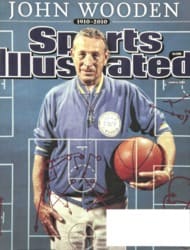
A Flight Of Fantasy
It was three hours before dawn on May 28 in a field near Ashford, England, when two dozen members of Jonathan Trappe's flight team began their work, inflating 20-foot-wide rubber balloons with helium and assembling them into a towering lollipop tree of reds, yellows, blues and greens. Just before 5 a.m., Trappe strapped himself into a harness clipped to the multicolored spheres and began to rise. This was not the high jinx of a balloon-boy hoax or a scene from the animated film Up. This idea was pure; this fantasy was real.
Trappe's crew of volunteers gleefully sent him into a brightening sky with the official cheer of England: Hip, hip, hooray! And then he heard nothing. No hum of a motor. No hiss of hot air. Trappe, a 36-year-old pilot and technical project manager from Raleigh, N.C., simply drifted away with the ease of a soap bubble. "The most powerful moment of emotion came just after takeoff. I was airborne, heading to the sunrise and the English Channel beyond," Trappe explained in an e-mail, adding, "The white cliffs [of Dover] are a symbol of [England], and I floated directly above them in complete silence as I headed out to sea."
The English Channel is a sportsman's seductress, a curvy body of water that beckons, Try me. For more than 200 years it has wooed the brave and adventurous, including U.S. Olympian Gertrude Ederle, the first woman to swim it (1926); America's Bryan Allen, the first to cross it in a pedal-powered aircraft (1979); and BBC host Christine Bleakley, the first to conquer it on water skis (March 2010), despite eight falls and one pause for a passing tanker. The list of firsts is long, and almost every passage has been fraught with struggle—against frigid and choppy seas, against physical pain and punishment. But Trappe, his feet dangling, was carried along for a four-hour journey on the shoulders of wind currents. To rise, he dropped ballast in the form of water from bags clipped to his harness. "It falls harmlessly back to earth," Trappe noted, "like so much rain." To descend, he could either puncture a balloon, creating a huge whoosh, or snip one free with scissors.
After navigating across a 22-mile-wide stretch of the Channel at heights of 7,500 feet, Trappe touched down in a farmer's cabbage patch outside Dunkirk, France, making him the first to cross the Channel in a cluster balloon. This wasn't an act of impetuous flakiness on the scale of Larry (Lawn Chair) Walters, who startled pilots taking off from Los Angeles International Airport in 1982 when he rose 16,000 feet in an aluminum patio chair borne aloft by weather balloons. No, Trappe, with months of planning and preparation, with recorded balloon flights at 17,930 feet under his belt, had gained clearance from aviation officials. He even had a registration plate fastened to his dream ride to prove it: N878-UP.
"When I lift off from an airfield, attached to a towering cluster of toy balloons, I see genuine amazement in children's eyes," Trappe detailed in his e-mail. "The miracle of this sport is that I see the same amazement in the eyes of their parents." Maybe that look is more envy than amazement. Maybe the first step in releasing adulthood angst, and its freight of terrorist threats, oil-soaked pelicans and LeBron's future address, is to simply hold on to the wonder of helium balloons: a universal symbol of joy. They aren't just for inhaling—and producing a voice in need of WD-40. They are taped to mailboxes to mark party houses, tied to flowers to celebrate birthdays and clenched in the hands of children at carnivals. And for a kid, there are two important questions in life: How many licks does it take to get to the center of a Tootsie Pop and how many balloons would you need to fly?
The answer is not 99 red balloons, as the song goes. It took 54 to guide Trappe over the English Channel on a trip to innocence. "That's the true miracle of this sport: We reawaken the dream that all of us once had, but has grown quiet," Trappe said. Until around age nine, everyone and everything can fly, from fairy godmothers to reindeer, from superheroes to friendly ghosts. But even after the fantasies fade, adults still treasure the idea of escapism, whether it's the old Calgon "take me away" ad or the recent Southwest "wanna get away?" slogan. Even when gravity gains on our old bones, we still covet the beauty of human flight, especially in sports: Dr. J taking off from the free throw line, Bobby Orr floating horizontally after a game-winning goal, Mary Lou Retton soaring in a back somersault, double-twist vault.
What Trappe revealed is that neither escapism nor flight is a commercial idea or a childhood fiction. From takeoff to landing, he welcomed everyone to come along for the ride. Often, those marking firsts can't help but make the moment about them. But Trappe discussed his flight in the collective—as in we did it, our launch, champagne all around. "That first dream of flight is [of] something that crosses cultures and crosses borders," Trappe said. "It is the curiosity and amazement of the entire world as seen through a child's eyes." Even as an adult, it's comforting to know that balloons still will never let you down.
Talk Back
If you want to comment on Point After or suggest a topic, send an e-mail to PointAfter@si.timeinc.com
Trappe touched down in a cabbage patch in France, making him the first to cross the English Channel in a cluster balloon.
PHOTO
JOHN BURGESS

